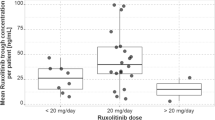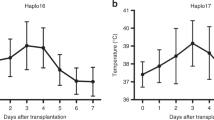Abstract
Purpose
Eleven patients diagnosed with various hematologic malignancies receiving an HLA-haploidentical hematopoietic cell transplant (HCT) participated in an ancillary biomarker trial. The goal of the trial was to evaluate potential pharmacologic biomarkers pertinent to the conditioning regimen [fludarabine monophosphate (fludarabine) and cyclophosphamide (CY)] or postgrafting immunosuppression [CY and mycophenolate mofetil (MMF)] in these patients.
Methods
We characterized the interpatient variability of nine pharmacologic biomarkers. The biomarkers evaluated were relevant to fludarabine (i.e., area under the curve (AUC) of 2-fluoro-ara-A or F-ara-A), CY (i.e., AUCs of CY and four of its metabolites), and MMF (i.e., total mycophenolic acid (MPA) AUC, unbound MPA AUC, and inosine monophosphate dehydrogenase (IMPDH) activity).
Results
Interpatient variability in the pharmacologic biomarkers was high. Among those related to HCT conditioning, the interpatient variability ranged from 1.5-fold (CY AUC) to 4.0-fold (AUC of carboxyethylphosphoramide mustard, a metabolite of CY). Among biomarkers evaluated as part of postgrafting immunosuppression, the interpatient variability ranged from 1.7-fold (CY AUC) to 4.9-fold (IMPDH area under the effect curve). There was a moderate correlation (R 2 = 0.441) of within-patient 4-hydroxycyclophosphamide formation clearance.
Conclusions
Considerable interpatient variability exists in the pharmacokinetic and drug-specific biomarkers potentially relevant to clinical outcomes in HLA-haploidentical HCT recipients. Pharmacodynamic studies are warranted to optimize the conditioning regimen and postgrafting immunosuppression administered to HLA-haploidentical HCT recipients.


Similar content being viewed by others
References
Bayraktar UD, Champlin RE, Ciurea SO (2012) Progress in haploidentical stem cell transplantation. Biol Blood Marrow Transpl 18:372–380
Luznik L, O’Donnell PV, Symons HJ, Chen AR, Leffell MS, Zahurak M, Gooley TA, Piantadosi S, Kaup M, Ambinder RF, Huff CA, Matsui W, Bolaños-Meade J, Borrello I, Powell JD, Harrington E, Warnock S, Flowers M, Brodsky RA, Sandmaier BM, Storb RF, Jones RJ, Fuchs EJ (2008) HLA-haploidentical bone marrow transplantation for hematologic malignancies using nonmyeloablative conditioning and high-dose, posttransplantation cyclophosphamide. Biol Blood Marrow Transpl 14:641–650
Brunstein CG, Fuchs EJ, Carter SL, Karanes C, Costa LJ, Wu J, Devine SM, Wingard JR, Aljitawi OS, Cutler CS, Jagasia MH, Ballen KK, Eapen M, O’Donnell PV, on behalf of the Blood and Marrow Transplant Clinical Trials Network (2011) Alternative donor transplantation after reduced intensity conditioning: results of parallel phase 2 trials using partially HLA-mismatched related bone marrow or unrelated double umbilical cord blood grafts. Blood 118:282–288
McCune JS, Batchelder AL, Deeg HJ, Gooley TA, Cole S, Phillips BR, Schoch HG, McDonald GB (2007) Cyclophosphamide following targeted oral busulfan as conditioning for hematopoietic cell transplantation: pharmacokinetics, liver toxicity, and mortality. Biol Blood Marrow Transpl 13:853–862
Giaccone L, McCune JS, Maris MB, Gooley TA, Sandmaier BM, Slattery JT, Cole S, Nash RA, Storb RF, Georges GE (2005) Pharmacodynamics of mycophenolate mofetil after nonmyeloablative conditioning and unrelated donor hematopoietic cell transplantation. Blood 106:4381–4388
Jacobson P, Rogosheske J, Barker JN, Green K, Ng J, Weisdorf D, Tan Y, Long J, Remmel R, Sawchuk R, McGlave P (2005) Relationship of mycophenolic acid exposure to clinical outcome after hematopoietic cell transplantation. Clin Pharmacol Ther 78:486–500
Baron F, Petersdorf EW, Gooley TA, Sandmaier BM, Malkki M, Chauncey TR, Maloney DG, Storb RF (2009) What is the role for donor natural killer cells after nonmyeloablative conditioning? Biol Blood Marrow Transpl 15:580–588
Lee SJ, Vogelsang G, Flowers MED (2003) Chronic graft-versus-host disease. Biol Blood Marrow Transpl 9:215–233
Salinger DH, Blough DK, Vicini P, Anasetti C, O’Donnell PV, Sandmaier BM, McCune JS (2009) A limited sampling schedule to estimate individual pharmacokinetic parameters of fludarabine in hematopoietic cell transplant patients. Clin Cancer Res 15:5280–5287
Woodahl EL, Wang J, Heimfeld S, Sandmaier BM, O’Donnell PV, Phillips B, Risler L, Blough DK, McCune JS (2008) A novel phenotypic method to determine fludarabine triphosphate accumulation in T-lymphocytes from hematopoietic cell transplantation patients. Cancer Chemother Pharmacol 63:391–401
McDonald GB, McCune JS, Batchelder AL, Cole S, Phillips BR, Ren AG, Vicini P, Witherspoon R, Kalhorn TF, Slattery JT (2005) Metabolism-based cyclophosphamide dosing for hematopoietic cell transplant. Clin Pharmacol Ther 78:298–308
Kalhorn TF, Howald WN, Cole S, Phillips BR, Wang J, Slattery JT, McCune JS (2006) Rapid quantitation of cyclophosphamide metabolites in plasma by liquid chromatography–mass spectrometry. J Chromatogr B Anal Technol Biomed Life Sci 835:105–113
Yeh ST (2002) Using trapezoidal rule for the area under a curve calculation. In: Proceedings of the 27th Annual SAS User Group International. http://www2.sas.com/proceedings/sugi27/p229-27.pdf. Accessed 28 Jun 2012
Soto Matos-Pita A, de Miguel Lillo B (2005) Noncompartmental pharmacokinetics and bioequivalence analysis. http://www.lexjansen.com/pharmasug/2005/statisticspharmacokinetics/sp07.pdf. Accessed 28 Jun 2012
Li H, Mager DE, Sandmaier BM, Maloney DG, Bemer MJ, McCune JS (2013) Population pharmacokinetics and dose optimization of mycophenolic acid in HCT recipients receiving oral mycophenolate mofetil. J Clin Pharmacol 53:393–402
Li H, Mager DE, Bemer MJ, Salinger DH, Vicini P, Sandmaier BM, Nash R, McCune JS (2012) A limited sampling schedule to estimate mycophenolic acid area under the concentration–time curve in hematopoietic cell transplantation recipients. J Clin Pharmacol 52:1654–1664
Glander P, Sombogaard F, Budde K, Gelder T, Hambach P, Liefeldt L, Lorkowski C, Mai M, Neumayer HH, Vulto AG et al (2009) Improved assay for the nonradioactive determination of inosine 5′-monophosphate dehydrogenase activity in peripheral blood mononuclear cells. Ther Drug Monit 31:351–359
Daxecker H, Raab M, Müller MM (2002) Influence of mycophenolic acid on inosine 5′-monophosphate dehydrogenase activity in human peripheral blood mononuclear cells. Clin Chim Acta 318:71–77
Duffy MJ, Crown J (2008) A personalized approach to cancer treatment: how biomarkers can help. Clin Chem 54:1770–1779
Hutchinson L, Devita VT (2010) Focus issue on biomarkers. Nat Rev Clin Oncol 7:295
McLeod HL, Isaacs KL (2011) Preemptive pharmacogenetic testing: insufficient data equal unsatisfactory guidance. Ann Intern Med 154:842–844
Sorger PK, Allerheiligen SRB, Abernethy DR, Altman RB, Brouwer KLR, Califano A, D’Argenio DZ, Iyengar R, Jusko WJ, Lalonde R, others Quantitative and systems pharmacology in the post-genomic era: new approaches to discovering drugs and understanding therapeutic mechanisms. http://www.nigms.nih.gov/NR/rdonlyres/8ECB1F7C-BE3B-431F-89E6-A43411811AB1/0/SystemsPharmaWPSorger2011.pdf. Accessed 30 Aug 2012
Gandhi V, Plunkett W (2002) Cellular and clinical pharmacology of fludarabine. Clin Pharmacokinet 41:93–103
Long-Boyle JR, Green KG, Brunstein CG, Cao Q, Rogosheske J, Weisdorf DJ, Miller JS, Wagner JE, McGlave PB, Jacobson PA (2010) High fludarabine exposure and relationship with treatment-related mortality after nonmyeloablative hematopoietic cell transplantation. Bone Marrow Transplant 46:20–26
Keating MJ, O’brien S, Lerner S, Koller C, Beran M, Robertson LE, Freireich EJ, Estey E, Kantarjian H (1998) Long-term follow-up of patients with chronic lymphocytic leukemia (CLL) receiving fludarabine regimens as initial therapy. Blood 92:1165–1171
Consoli U, El-Tounsi I, Sandoval A, Snell V, Kleine HD, Brown W, Robinson JR, DiRaimondo F, Plunkett W, Andreeff M (1998) Differential induction of apoptosis by fludarabine monophosphate in leukemic B and normal T cells in chronic lymphocytic leukemia. Blood 91:1742–1748
Gamberale R, Galmarini CM, Fernández-Calotti P, Jordheim L, Sánchez-Avalos J, Dumontet C, Geffner J, Giordano M (2003) In vitro susceptibility of CD4+ and CD8+ T cell subsets to fludarabine. Biochem Pharmacol 66:2185–2191
Wilkins RC, Kutzner BC, Truong M, McLean JRN (2002) The effect of the ratio of CD4+ to CD8+ T-cells on radiation-induced apoptosis in human lymphocyte subpopulations. Int J Radiat Biol 78:681–688
Mariotti J, Taylor J, Massey PR, Ryan K, Foley J, Buxhoeveden N, Felizardo TC, Amarnath S, Mossoba ME, Fowler DH (2011) The pentostatin plus cyclophosphamide nonmyeloablative regimen induces durable host T cell functional deficits and prevents murine marrow allograft rejection. Biol Blood Marrow Transpl 17:620–631
Castermans E, Hannon M, Dutrieux J, Humblet-Baron S, Seidel L, Cheynier R, Willems E, Gothot A, Vanbellinghen J-F, Geenen V, Sandmaier BM, Storb R, Beguin Y, Baron F (2010) Thymic recovery after allogeneic hematopoietic cell transplantation with non-myeloablative conditioning is limited to patients younger than 60 years of age. Haematologica 96:298–306
Bhalla K, Bullock G, Lutzky J, Holladay C, Ibrado AM, Jasiok M, Singh S (1992) Effect of combined treatment with interleukin-3 and interleukin-6 on 4-hydroperoxycyclophosphamide-mediated reduction of glutathione levels and cytotoxicity in normal and leukemic bone marrow progenitor cells. Leukemia 6:814–819
Watters JW, Kloss EF, Link DC, Graubert TA, McLeod HL (2003) A mouse-based strategy for cyclophosphamide pharmacogenomic discovery. J Appl Physiol 95:1352–1360
Jones RJ, Zuehlsdorf M, Rowley SD, Hilton J, Santos GW, Sensenbrenner LL, Colvin OM (1987) Variability in 4-hydroperoxycyclophosphamide activity during clinical purging for autologous bone marrow transplantation. Blood 70:1490–1494
Zhong RK, Donnenberg AD, Rubin J, Ball ED (1994) Differential effect of 4-hydroperoxycyclophosphamide and antimyeloid monoclonal antibodies on T and natural killer cells during bone marrow purging. Blood 83:2345–2351
Ozer H, Cowens JW, Colvin M, Nussbaum-Blumenson A, Sheedy D (1982) In vitro effects of 4-hydroperoxycyclophosphamide on human immunoregulatory T subset function. I. Selective effects on lymphocyte function in TB cell collaboration. J Exp Med 155:276–290
Busse D, Busch FW, Bohnenstengel F, Eichelbaum M, Fischer P, Opalinska J, Schumacher K, Schweizer E, Kroemer HK (1997) Dose escalation of cyclophosphamide in patients with breast cancer: consequences for pharmacokinetics and metabolism. J Clin Oncol 15:1885–1896
Busse D, Busch FW, Schweizer E, Bohnenstengel F, Eichelbaum M, Fischer P, Schumacher K, Aulitzky WE, Kroemer HK (1999) Fractionated administration of high-dose cyclophosphamide: influence on dose-dependent changes in pharmacokinetics and metabolism. Cancer Chemother Pharmacol 43:263–268
Salinger DH, McCune JS, Ren AG, Shen DD, Slattery JT, Phillips BR, McDonald GB, Vicini P (2006) Real-time dose adjustment of cyclophosphamide in a preparative regimen for hematopoietic cell transplant: a Bayesian pharmacokinetic approach. Clin Cancer Res 12:4888–4898
Allison AC, Eugui EM (2000) Mycophenolate mofetil and its mechanisms of action. Immunopharmacology 47:85–118
Laverdière I, Caron P, Couture F, Guillemette C, Levesque E (2012) Liquid chromatography-coupled tandem mass spectrometry based assay to evaluate inosine-5′-monophosphate dehydrogenase activity in peripheral blood mononuclear cells from stem cell transplant recipients. Anal Chem 84:216–223
Glander P, Hambach P, Braun K-P, Fritsche L, Giessing M, Mai I, Einecke G, Waiser J, Neumayer H-H, Budde K (2004) Pre-transplant inosine monophosphate dehydrogenase activity is associated with clinical outcome after renal transplantation. Am J Transplant 4:2045–2051
Upton A, McCune JS, Kirby KA, Leisenring W, McDonald GB, Batchelder AL, Marr KA (2007) Fluconazole coadministration concurrent with cyclophosphamide conditioning may reduce regimen-related toxicity postmyeloablative hematopoietic cell transplantation. Biol Blood Marrow Transpl 13:760–764
De Jonge ME, Huitema ADR, Rodenhuis S, Beijnen JH (2005) Clinical pharmacokinetics of cyclophosphamide. Clin Pharmacokinet 44:1135–1164
Gilbert CJ, Petros WP, Vredenburgh J, Hussein A, Ross M, Rubin P, Fehdrau R, Cavanaugh C, Berry D, McKinstry C et al (1998) Pharmacokinetic interaction between ondansetron and cyclophosphamide during high-dose chemotherapy for breast cancer. Cancer Chemother Pharmacol 42:497–503
Raccor BS, Claessens AJ, Dinh JC, Park JR, Hawkins DS, Thomas SS, Makar KW, McCune JS, Totah RA (2012) Potential contribution of cytochrome P450 2B6 to hepatic 4-hydroxycyclophosphamide formation in vitro and in vivo. Drug Metab Dispos 40:54–63
Lindley C, Hamilton G, McCune JS, Faucette S, Shord SS, Hawke RL, Wang H, Gilbert D, Jolley S, Yan B, Lecluyse EL (2002) The effect of cyclophosphamide with and without dexamethasone on cytochrome P450 3A4 and 2B6 in human hepatocytes. Drug Metab Dispos 30:814–822
Acknowledgments
The authors would like to thank the participants and their caregivers for their time and cooperation, as well as the patient care staff for their support of this project. We would also like to acknowledge Ms. Megan Kelton-Rehkopf for her contributions to study coordination, Dr. David Blough for his statistical expertise, and Ms. Linda Risler and Mr. Brian Phillips for their analytical expertise. This study was supported by grants from the National Institutes of Health (HL91744S1, CA78902).
Conflict of interest
None.
Author information
Authors and Affiliations
Corresponding author
Electronic supplementary material
Below is the link to the electronic supplementary material.
Rights and permissions
About this article
Cite this article
Bemer, M.J., Sorror, M., Sandmaier, B.M. et al. A pilot pharmacologic biomarker study in HLA-haploidentical hematopoietic cell transplant recipients. Cancer Chemother Pharmacol 72, 607–618 (2013). https://doi.org/10.1007/s00280-013-2232-8
Received:
Accepted:
Published:
Issue Date:
DOI: https://doi.org/10.1007/s00280-013-2232-8




